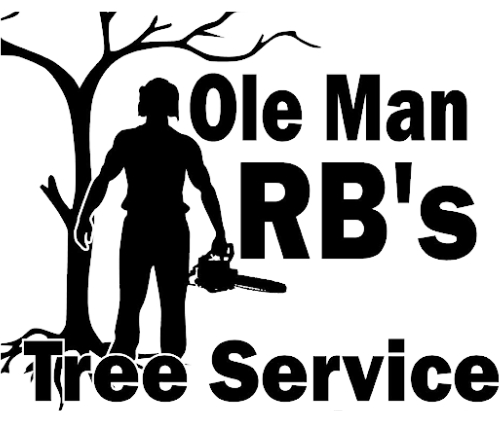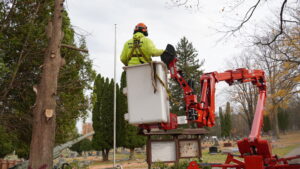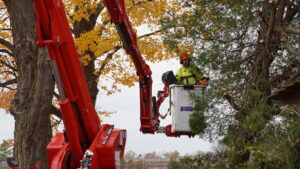
Trees are more than just landscaping—they’re living structures that protect your home, boost curb appeal, and raise property value. But just like any living thing, trees can get sick. If you ignore the early warning signs, what starts as a minor issue can become a major hazard.
At Ole Man RB’s Tree Service, we’ve seen how unnoticed tree health issues can result in fallen limbs, property damage, and costly emergency removals. If you own property in Michigan, spotting a sick tree early can save you thousands—and maybe even protect your home or family.
Here are the top 5 warning signs your trees might be sick or dying and what to do about them.
1. Sudden or Unseasonal Leaf Loss
Healthy trees don’t shed leaves in the middle of summer. If your tree is dropping leaves out of season, especially if entire branches are going bare something’s wrong. Leaf drop is often the tree’s way of conserving energy due to stress, pest invasion, or disease. What to look for:
- Bare branches while nearby trees are still full
- Discolored or spotted leaves before dropping
- Leaf loss starting at the crown (top) or one side of the tree
Common causes: root damage, fungal infections, drought stress, or girdling roots.
What to do: Call for an inspection. Early intervention could reverse damage before the tree reaches the point of no return.
2. Cracks or Splits in the Trunk
The trunk is your tree’s structural backbone. Large vertical cracks, open wounds, or visible splits, especially ones that deepen over time, are major red flags. These weaken the tree’s ability to transport nutrients and increase the risk of collapse. What to look for:
- Large vertical cracks running down the trunk
- Bark peeling away to expose wood
- Hollow sounds when you knock on the trunk
Common causes: freeze-thaw cycles (especially in Michigan winters), lightning strikes, internal decay.
What to do: Don’t ignore trunk damage. This is a serious structural issue that requires immediate professional evaluation.
3. Mushrooms or Fungi Growing at the Base
Dead limbs are more than an eyesore; they’re dangerous. If you notice brittle, leafless, or hanging branches that break off easily, your tree may be in decline. These limbs are often referred to as “widowmakers” because they can fall without warning.
What to look for:
- Mushrooms, conks, or shelf fungi near the roots
- Soft, spongy bark at the base
- Musty or rotting odor around the tree
Common causes: poor drainage, old age, root rot, and fungal pathogens like Armillaria.
What to do: Fungal presence typically means decay. Schedule a risk assessment as soon as possible to determine if removal or cabling is needed.
4. Dead or Hanging Branches
Dead limbs are more than an eyesore; they’re dangerous. If you notice brittle, leafless, or hanging branches that break off easily, your tree may be in decline. These limbs are often referred to as “widowmakers” because they can fall without warning. What to look for:
- Limbs that snap off with little effort
- No buds or leaf growth on certain branches
- Branches with peeling or cracked bark
Common causes: lack of nutrients, pest damage, disease, or root trauma.
What to do: Deadwood should be removed immediately, even if the rest of the tree seems healthy. It’s also a sign the tree may be dying internally.
5. Bark Is Falling Off or Looks “Chunky”
Bark is a tree’s protective armor. If it starts falling off in large chunks or the surface looks cracked, flaking, or dry, it’s often a sign of illness or decline. What to look for:
- Bare patches of exposed wood
- Bark that’s easy to peel off by hand
- Large strips of bark missing around the trunk
Common causes: disease, insect infestation, dehydration, or long-term stress.
What to do: Bark loss often indicates internal damage. The longer you wait, the greater the chance the tree may need to be removed entirely.
Why It Matters: Safety, Liability and Cost
A sick tree doesn’t just affect your yard’s appearance; it creates a liability risk. Falling branches, collapsed trunks, and hidden decay can damage roofs, vehicles, and power lines, and in some cases, injure someone.
Plus, insurance companies often won’t cover damage if the tree was “obviously decayed” or “previously reported as hazardous.” That puts the full financial burden on you.
Don’t Wait Until It Falls—Take Action Now
Tree health issues don’t fix themselves. If your tree is showing any of the signs above, it’s time to bring in the pros.
At Ole Man RB’s Tree Service, we provide:
- Expert tree health evaluations
- Strategic pruning and cabling
- Hazardous tree removal
- Emergency storm service across Michigan
We serve residential and commercial properties across Michigan with safe, certified, and insured tree services designed to protect your home and landscape year-round.
Schedule Your Free Tree Health Inspection Today
Protect your home. Avoid preventable damage. And save money in the long run.
Call Ole Man RB’s Tree Service
Serving Michigan homeowners and businesses
Book your free on-site evaluation today





This is my first time pay a quick visit at here and i am really happy to read everthing at one place